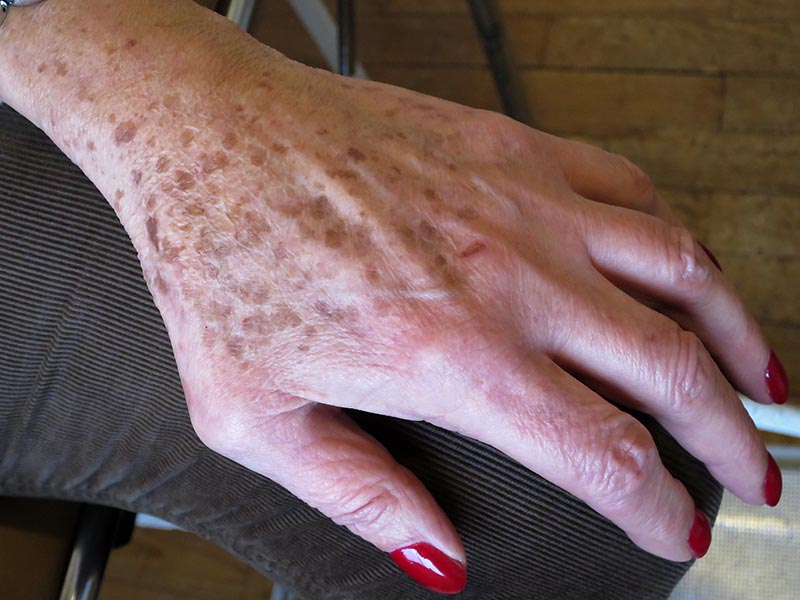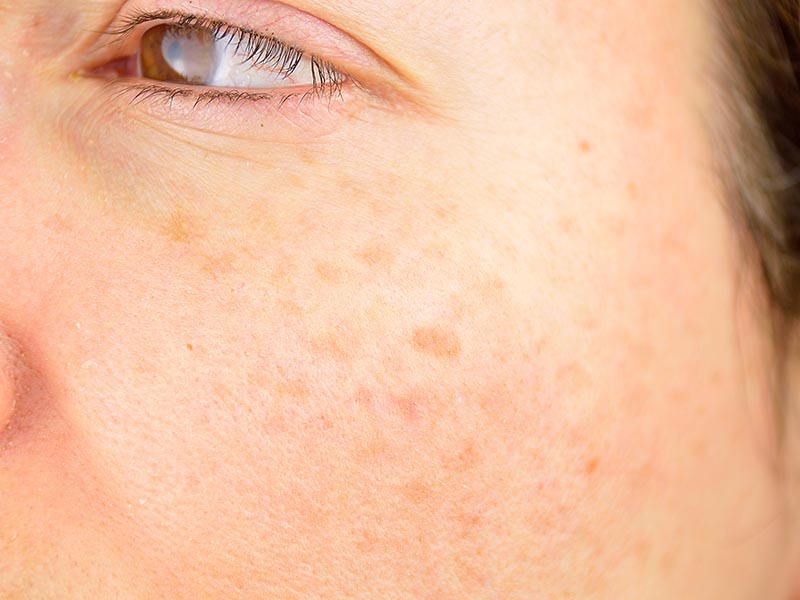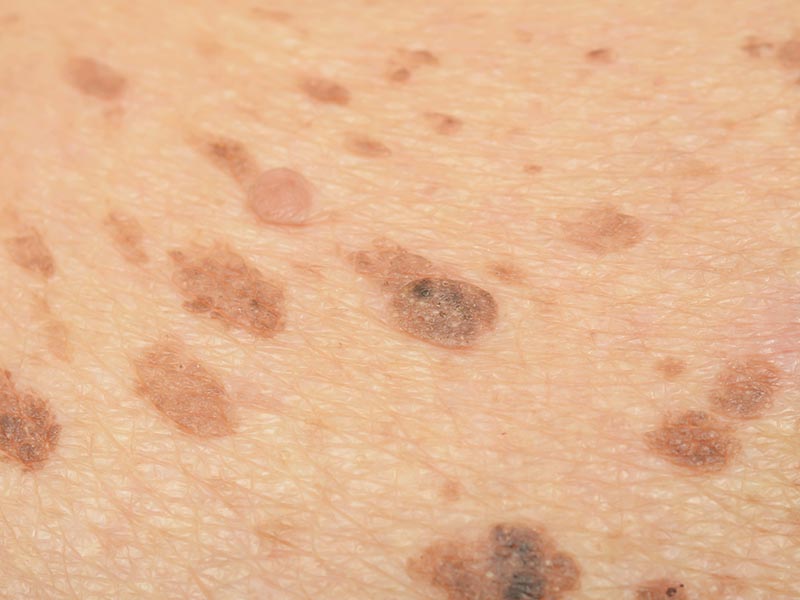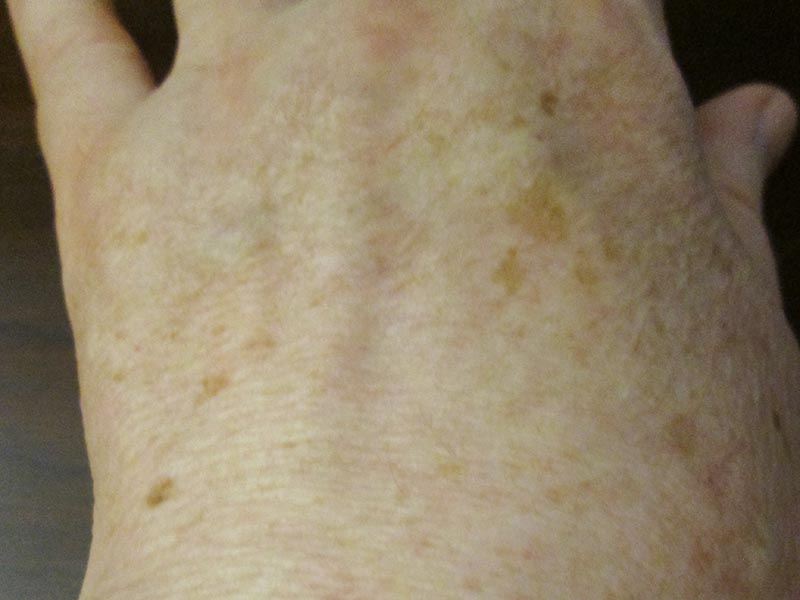The word lentigo simply describes a patch of skin that contains a greater density of cells called melanocytes which produce a dark pigment called melanin. There are many different types of lentigo, but the commonest are caused by the sun – solar lentigos. These are non-cancerous brown spots which are thought to develop in response to sun-exposure, especially in those with fairer skin. They can appear anywhere but tend to form on the face, neck, shoulders and forearms. Unlike freckles they usually appear after the age of 30.
The main difference between a freckle and a solar lentigo is that in a freckle only the amount of pigment being produced by melanocytes is increased, rather than the actual number of cells.
Alternative names: Liver spot, old age spot, senile freckle, sun spots (singular: lentigo).
REQUEST A CALL BACK
Arrange a consultation with one of our expert dermatologists today.
WHAT DO SOLAR LENTIGOS AND FRECKLES LOOK LIKE?
Solar lentigos are flat spots which vary in colour from yellow-brown to dark brown-black, depending on skin tone. They are generally much larger than freckles being >5mm in width. The number and size of solar lentigos often increases with age, and in comparison to freckles, they do not fade much during the winter months.
Though freckles and solar lentigos are harmless, it is important to recognise certain differences between these and early malignant melanoma (a type of skin cancer). If a brown spot with an irregular border or multiple colours has appeared recently, or if you have any doubts, please seek medical advice immediately.

Though freckles and solar lentigines may be mistaken for malignant melanoma, they do not themselves turn into cancer, and thus are benign. However, some people find them cosmetically unappealing, especially on the face.




HOW CAN SOLAR LENTIGOS AND FRECKLES BE TREATED?
Adopting good sun-protection habits is the best way to prevent freckles and solar lentigines from developing or worsening. Cover up, especially between peak times from 11-4pm during hot days and wear sunscreen on exposed sites. However, for those that have already formed, there are treatments available to reduce their appearance.
Briefly these include:
- Lightening creams containing tretinoin or hydroquinone
- Chemical peels
- Cryotherapy (freezing)
- Laser treatments
- Intense pulsed light treatment
The aesthetic outcome of these therapies varies from person-to-person, but in experienced hands results can be impressive.
Our Specialist Dermatologists at the Harley Street Dermatology Clinic can offer effective treatment for all types of sun damage including solar lentigos.
For further information please click here
FREQUENTLY ASKED QUESTIONS
Can freckles turn into moles?
No, freckles can’t turn into moles. Freckles appear due to sun exposure or genetics, whereas moles appear after the skin cells develop into a cluster instead of spreading out on the skin.
What age do freckles most commonly appear?
The average age that children develop freckles is between 2 and 4 years old.
Are freckles a sign of sun damage?
Freckles actually act like sun cream and are a natural way for the skin to block dangerous UV rays from penetrating the deeper layers of skin. They aren’t a sign of sun damage but actually project areas of the skin that are particularly sensitive to UV light.
Are freckles dangerous?
Though freckles and solar lentigines may be mistaken for malignant melanoma, they do not themselves turn into cancer, and thus are benign. However, some people find them cosmetically unappealing, especially on the face.
What causes freckles to suddenly appear?
The exposure to UV-B radiation activates melanocytes to increase melanin production, which can cause freckles to become darker and more visible. Freckles are therefore more visible following exposure to sunlight.
WHY CHOOSE THE HARLEY STREET DERMATOLGY CLINIC?
Having the right dermatologist is important especially when you have a chronic skin condition that will require ongoing treatment. We want you to feel confident that we’re providing you with the best possible care. We also want you to feel as comfortable as possible with your dermatologist.
The Harley Street Dermatology Clinic specialises in conditions affecting the skin, hair and nails. Our goal is to provide all the care that you need when you’re experiencing these kinds of problems. We want to make it easy for you to access the best quality treatment and support in London.
The clinic is conveniently located in Central London, so it’s easy to visit us if you need to see a dermatologist. You will find yourself in a very comfortable and welcoming environment. We have created a relaxing space where you will receive the highest quality of care. We are regulated by the Care Quality Commission, are part of the British Association of Dermatologists and are top rated by patients of Doctify so you can be sure of safe and effective treatment with us.
CONTACT US
Finding Us
The Harley Street Dermatology Clinic
35 Devonshire Place
London
W1G 6JP
The clinic can be accessed by public transport, on foot or by car. There is paid on street parking around the Harley Street district. The nearest tube stations are Regent’s Park and Baker Street, and Marylebone train station is a 15 minute walk away.
Contact Details
Opening Hours
While appointments can be made available outside usual hours in special circumstances, our core hours are:
Monday: 8am - 6pm
Tuesday: 8am - 6pm
Wednesday: 8am - 6pm
Thursday: 8am - 6pm
Friday: 8am - 6pm
Saturday : 10am - 2pm
Sunday: Closed
REQUEST A CALL BACK
Please fill in this form and one of our team will give you a call back to arrange a consultation with one of our expert dermatologists.
